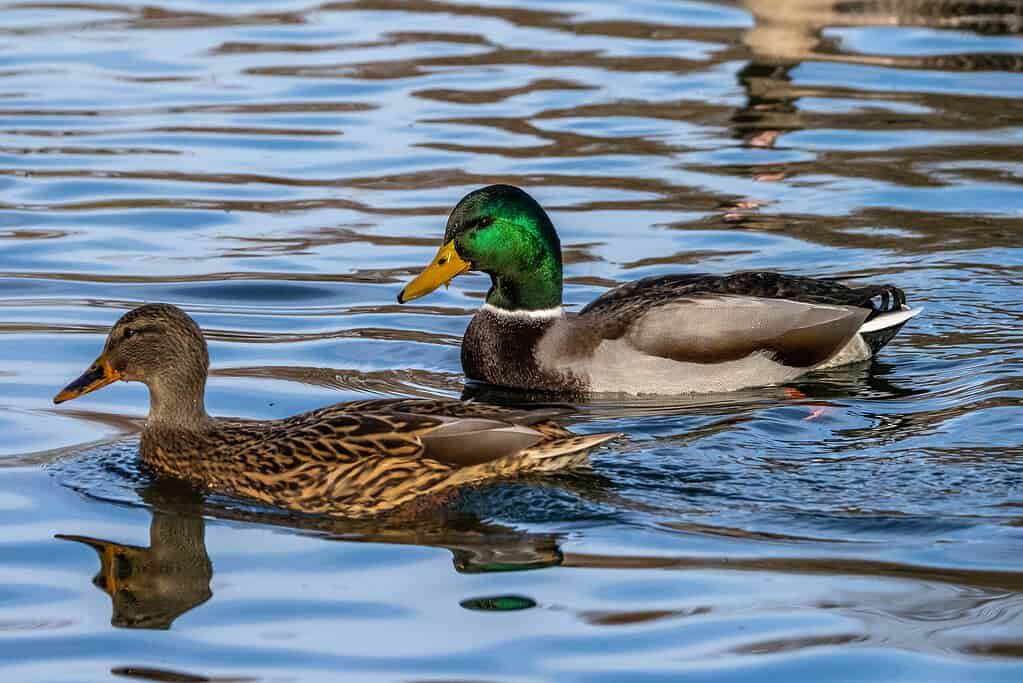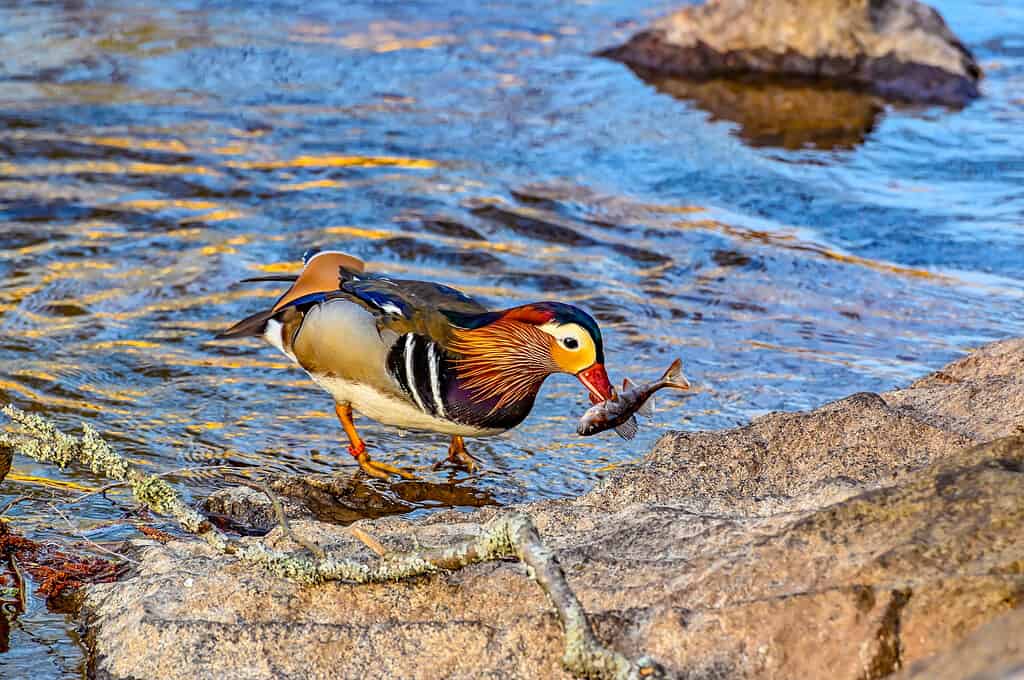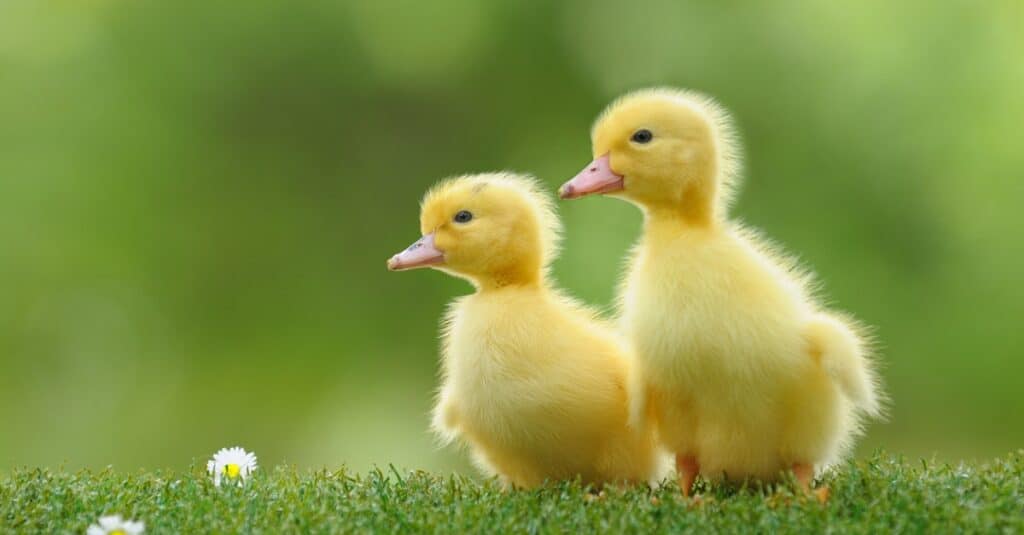Welcome to our comprehensive guide on duck mating! From courtship rituals to intricate mating behaviors, join us as we uncover the wonders of how ducks mate and propagate their species.
The Differences Between Male and Female Ducks

Male mallard ducks have bright green heads and brown and cream feathers on their bodies. Females are brown all over.
©iStock.com/Rudolf Ernst
Ducks are a species of bird that are known for their unique characteristics, from their vibrant colors to their quacking sounds. Ducks come in both male and female varieties, and there are some distinct differences between the two.
Male ducks, also known as drakes, are generally more brightly colored than their female counterparts. This is because they use their colors and feathers to attract mates. Males also tend to have larger bodies than females, with broader bills and longer tails.
Female ducks, also known as hens, are typically duller in color and have a more modest bill and tail. They also tend to be slightly smaller than males. Females are also the ones that take on childcare duties, such as incubating eggs and caring for ducklings.
The behavior of male and female ducks is also quite different. Males will often be seen displaying to attract mates, while hens are more likely to stick to the sidelines. Males can also be more aggressive during mating season, while females are usually more passive.
Overall, male and female ducks are quite different in terms of their appearance, behavior, and duties. Although they look similar, there are distinct differences between the two that are easy to spot. Knowing the differences between male and female ducks is essential to spotting them in nature.
Breeding Behavior of Ducks

You can see here that the male duck is courting the female duck by raising his tail feathers and lowering his head.
©Kendall Collett/Shutterstock.com
Ducks are generally monogamous birds, meaning they form pair bonds with a single mate for the breeding seasons. Ducks do not mate for life, like some other birds, but are monogamous for the season only. During mating season, typically in spring, female ducks may lay up to 12 eggs in a nest. However, the average is usually closer to 8. Ducks will become more territorial as mating season approaches, and the male duck will often perform courtship displays to attract a female partner.
Once the eggs are laid, the female typically incubates them for 28-35 days. Meanwhile, the male will stay nearby to guard the nest against predators. Immediately after hatching, the ducklings will be led to the water by their parents, where they will learn to feed and swim.
Ducks are typically independent by the age of one month, and in the wild, the young ducks will remain with their parents for up to a year before they go off on their own.
Signs That A Duck Is Ready To Mate
- Increase in aggressive behavior
- Display of courtship rituals such as preening and head bobbing
- The male duck will attempt to attract a mate with a loud quacking or whistling sound.
- Male ducks will become more territorial and try to defend their territory from other males.
- The female duck will be more receptive to the male duck’s advances.
Duck Courtship Displays

Male and female ducks go to great lengths to get each other’s attention.
©Olexandr Panchenko/Shutterstock.com
Duck courtship displays involve a variety of behaviors, including the grunt whistle and “head-up-tail-up.” The grunt whistle is used by males to attract female ducks and consists of a series of low-frequency grunting noises followed by a high-pitched whistle. It looks like the duck is about to dive underwater, but instead, he arches his head forward, and he gracefully scoops up water with his bill and drops it toward the female.
The “down-up” is a bowing motion performed by males to show submission to females. The “head-up-tail-up” is a posture used by males to demonstrate dominance and is characterized by the male raising his head and tail up in the air. He shows off the beautiful purple under feathers. She is sure to be impressed by this!
Female ducks frequently engage in nod-swimming, which involves rapidly swimming for a brief period with their neck held low, nearly skimming the surface of the water. This behavior is used to show that they are ready to start courting and encourages the males in the area to display their mating rituals. She may also exhibit head-pumping or bobbing while following after her prospective mate.
Factors That Influence the Timing of Mating Season for Ducks

Ducks mate when sunlight, food, and warm waters are abundant.
©iStock.com/Jonas Rönnbro
The mating season for ducks is influenced by a variety of factors, including environmental factors, hormonal changes, and social interactions.
Environmental Factors
Environmental factors such as the availability of food, nesting sites, and water in the ducks’ habitat can have a major influence on the timing of the mating season. For example, ducks are more likely to mate when there is plenty of food available, as well as ample nesting sites and water for the ducks to swim in. The longer sunlight hours of spring and summer also indicate that it is time to breed, as well as warmer water temperatures.
Hormonal Changes
Hormonal changes also play an important role in the timing of mating season for ducks. During the mating season, male ducks experience an increase in testosterone levels, which can prompt them to seek out a mate and begin courting. Females, on the other hand, may experience an increase in estrogen levels, which can prompt them to exhibit behaviors such as preening and flirting.
Social Interactions
Social interactions between ducks can also influence the timing of the mating season. During the breeding season, ducks may form pairs or small groups and engage in courtship displays. These displays may involve preening, calling, and swimming in circles and can help to attract potential mates and prompt them to begin courting.
Strategies for Successful Mating of Ducks in the Wild

Muscovy ducks build their nests between 10 and 65 feet off the ground in the hollows of old trees.
©iStock.com/dossyl
Mating in the wild is essential for ducks to reproduce and ensure the survival of their species. Here are some strategies to help ducks successfully mate in the wild:
Establish Territories
Male ducks typically establish territories in the spring where they will attract mates. These territories can be located near food sources, nesting sites, and other areas that female ducks may find attractive. Establishing a territory is an important step for successful mating as it ensures that the male ducks can attract a mate.
Develop Courtship Displays
Once a territory has been established, males will often perform courtship displays to attract potential mates. These displays may include vocalizations, swimming, and preening and can be used to show off their feathers and impress potential mates.
Find the Right Nesting Site
Finding the right nesting site is another important part of successful mating for ducks. Ducks prefer to nest in areas that are close to water and provide protection from predators. Once the female has selected a nesting site, she will lay her eggs, and the male will help to incubate them.
Provide Protection
Once the eggs have been laid, the male duck will provide protection for the nest and the eggs by warding off predators. This is an important step for successful mating as it ensures that the eggs will be safe until they hatch.
With these strategies, ducks can successfully mate in the wild and ensure the survival of their species.
Duck Gestation

Some ducks build their nests directly on the ground. Be careful where you step!
©Maximillian cabinet/Shutterstock.com
The average gestation period for ducks is 28-35 days. During that time, the female duck will build a nest and lay eggs. She will incubate her eggs for the duration of the gestation period, and once the eggs hatch, she will take care of her young. Ducks typically lay between 8-15 eggs per clutch and can have multiple clutches throughout the year. The ducklings will reach maturity within 4-5 months and will be able to breed as early as six months of age.
Duck Egg Incubation Conditions
Duck eggs typically take 28 days to hatch. To ensure successful hatching, the incubation temperature should be kept at 99.5-100.5°F, and the humidity should remain between 55-75%. The mama duck creates these ideal conditions by sitting on the eggs and surrounding them with her wings and body heat. Duck eggs are generally larger than chicken eggs, measuring on average about 2.75 inches in length and 2 inches in width.
Common Misconceptions about Duck Mating Habits

Baby ducklings eat bugs, algae, plant matter, and seeds.
©shaftinaction/Shutterstock.com
Many people believe that ducks mate for life, but this is not the case. In reality, ducks will often change partners depending on the season or availability of mates. Ducks also do not mate with the same partner year after year; instead, they will form new pair bonds each year.
Contrary to popular belief, female ducks are also quite capable of choosing their own mates and will often reject a potential partner if they are not interested. Finally, although ducks may form strong pair bonds, it is not unheard of for them to engage in extra-pair copulations with other ducks. This is especially true of domesticated ducks.
The Importance of Understanding the Reproductive Cycle of Ducks for Conservation Efforts

All animals are important to the ecosystem and deserve our consideration and care.
©iStock.com/therry
The reproductive cycle of ducks is a critical factor in effective conservation efforts. Ducks are migratory species that, depending on the species, breed in different parts of the world. By understanding the reproductive cycle, conservationists can better assess the population of ducks, determine which areas need more protection, and implement strategies to ensure the survival of the species. Additionally, understanding the reproductive cycle allows conservationists to identify and address threats to the population, such as habitat destruction, pollution, and hunting.
The photo featured at the top of this post is © Eric Isselee/Shutterstock.com
Thank you for reading! Have some feedback for us? Contact the AZ Animals editorial team.






